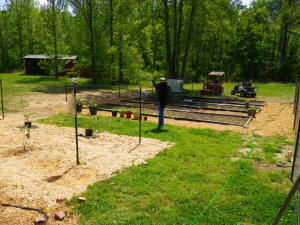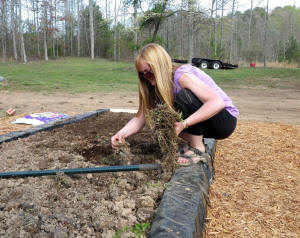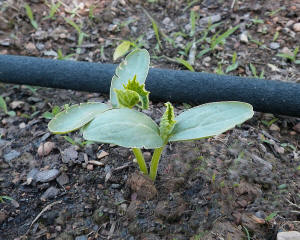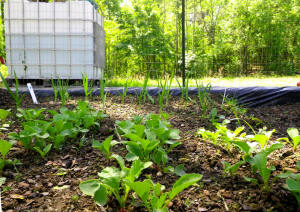| ||||
Friday, April 27, 2012
Thursday, April 26, 2012
Micro Farm Update - Raised Bed Vegetable Garden
April 26 - 2012 - More
When we started this part of our micro farm project, we knew very little about  raised bed gardens. Our parents had gardens when we were children, but as adults, we've never undertaken such a project. Rebecca purchased a book titled Mini Farming: Self-Sufficiency on 1/4 Acre by Bret Markham, and it has proven to be an invaluable resource which I repeatedly reference as the project progresses. Additionally, various gardening blogs, videos, and governmental and educational websites have provided guidance, albeit sometimes incorrect or dated. raised bed gardens. Our parents had gardens when we were children, but as adults, we've never undertaken such a project. Rebecca purchased a book titled Mini Farming: Self-Sufficiency on 1/4 Acre by Bret Markham, and it has proven to be an invaluable resource which I repeatedly reference as the project progresses. Additionally, various gardening blogs, videos, and governmental and educational websites have provided guidance, albeit sometimes incorrect or dated. Being on a shoestring budget, my fir _small.jpg) st big investment was the purchase of 18 used railroad crossties for the sum of $90. They're heavy enough to stay in place and they'll last forever. For peace of mind, I used heavy gauge plastic to create a watertight and airtight barrier between the crossties and the garden bed. I used cheap 1"x 2"s as stakes to hold the crossties in place, then filled and packed dirt between the beds to stabilize them. Shimming with bricks to level the crossties created beds with between 12"- 16" of amended and finely tilled topsoil. After their installation, the 18 crossties established three 24' x 5' beds for a total of 360 square feet of garden space. st big investment was the purchase of 18 used railroad crossties for the sum of $90. They're heavy enough to stay in place and they'll last forever. For peace of mind, I used heavy gauge plastic to create a watertight and airtight barrier between the crossties and the garden bed. I used cheap 1"x 2"s as stakes to hold the crossties in place, then filled and packed dirt between the beds to stabilize them. Shimming with bricks to level the crossties created beds with between 12"- 16" of amended and finely tilled topsoil. After their installation, the 18 crossties established three 24' x 5' beds for a total of 360 square feet of garden space.
Filling three very large beds with dirt could have been quite a chore.
 Fortunately, we have access to my father's tractor equipped with a bucket. It made short work of gathering topsoil from our little cove and placing it in the beds. I designed the beds' width and spacing based on the tractor's wheelbase and bucket width. I can easily drive between and through the beds if necessary. The soil is dark and rich (probably from 22 years of my fertilizer and expensive topsoil running off my lawn). Unfortunately, the dirt is also riddled with fescue sod and clover roots a foot deep. We hand hoed one Fortunately, we have access to my father's tractor equipped with a bucket. It made short work of gathering topsoil from our little cove and placing it in the beds. I designed the beds' width and spacing based on the tractor's wheelbase and bucket width. I can easily drive between and through the beds if necessary. The soil is dark and rich (probably from 22 years of my fertilizer and expensive topsoil running off my lawn). Unfortunately, the dirt is also riddled with fescue sod and clover roots a foot deep. We hand hoed one _small.jpg) of the beds because out tiller was on the fritz. I ended-up renting a small tiller for the next weekend. It was $40 well spent. I added some peat and bagged garden soil to make it a little fluffier and help it hold moisture, then pulverized it. I wanted to add vermiculite, but I couldn't find any locally before planting time. I'll add some next fall. of the beds because out tiller was on the fritz. I ended-up renting a small tiller for the next weekend. It was $40 well spent. I added some peat and bagged garden soil to make it a little fluffier and help it hold moisture, then pulverized it. I wanted to add vermiculite, but I couldn't find any locally before planting time. I'll add some next fall.
With the beds in place, our next concern was protecting
 our hard work from total destruction by our goats and chickens, or by the many deer visitors we receive in our little cove. The best deal I could find was 5' high welded-wire fence. It may seem short to some, but our deer are small than some, and I'm keeping my fingers crossed they'll not be tempted enough to attempt the jump. purchased two 100' rolls of fencing and a dozen or so 6.5' t-posts. I constructed an inexpensive gate using 2" PVC pipe and left-over fencing. Once it was all set-up, it worked great. our hard work from total destruction by our goats and chickens, or by the many deer visitors we receive in our little cove. The best deal I could find was 5' high welded-wire fence. It may seem short to some, but our deer are small than some, and I'm keeping my fingers crossed they'll not be tempted enough to attempt the jump. purchased two 100' rolls of fencing and a dozen or so 6.5' t-posts. I constructed an inexpensive gate using 2" PVC pipe and left-over fencing. Once it was all set-up, it worked great.
With the bulk of the infrastructure completed, we decided to begin
 planting our garden although it was just a little early for some of the plants. This year it's been extremely mild, and everything is about a month ahead. On our first planting, we sowed radishes, garlic, cucumbers, peas, corn, and planted tomato seedlings. A week or so later, we followed-up with lettuce, lima beans, pole beans, okra, squash, zucchini, a variety of peppers, watermelon, cantaloupe, onions, carrots. As of mid-late April, everything is up and looking hardy. We had a three close calls with frost, but we beat the monster (see plastic on the beds). planting our garden although it was just a little early for some of the plants. This year it's been extremely mild, and everything is about a month ahead. On our first planting, we sowed radishes, garlic, cucumbers, peas, corn, and planted tomato seedlings. A week or so later, we followed-up with lettuce, lima beans, pole beans, okra, squash, zucchini, a variety of peppers, watermelon, cantaloupe, onions, carrots. As of mid-late April, everything is up and looking hardy. We had a three close calls with frost, but we beat the monster (see plastic on the beds).
We are slowly learning what is
 good to plant together and what is not. I don't think we made too many bad mistakes this first time around. We are definitely experimenting with the "Three Sisters" planting scheme of squash, corn, and climbing beans and peas. I am also trying a few neat ideas I discovered from the Backyard Farming book and online. For instance, we are training our tomatoes and some of our cucumbers to climb a string trellis to save room in the bed. good to plant together and what is not. I don't think we made too many bad mistakes this first time around. We are definitely experimenting with the "Three Sisters" planting scheme of squash, corn, and climbing beans and peas. I am also trying a few neat ideas I discovered from the Backyard Farming book and online. For instance, we are training our tomatoes and some of our cucumbers to climb a string trellis to save room in the bed.
Ke
_small.jpg) eping the garden watered through our hot dry summers is a top priority, especially when we may be out of town several days at a time. To solve this problem, we purchased a used (like new) 275 gallon water tote (Craigslist $50), a two-zone watering timer, some soaker watering hoses ($11ea), and a variety of adapters and splitters to make it all work. I'm currently experimenting with getting a good even water coverage in all three beds. I may have to add another two-zone watering timer before all is said and done. eping the garden watered through our hot dry summers is a top priority, especially when we may be out of town several days at a time. To solve this problem, we purchased a used (like new) 275 gallon water tote (Craigslist $50), a two-zone watering timer, some soaker watering hoses ($11ea), and a variety of adapters and splitters to make it all work. I'm currently experimenting with getting a good even water coverage in all three beds. I may have to add another two-zone watering timer before all is said and done.
In addition to building raised beds for vegetables, we also used the new fenc
 ed area to plant some grape vines, blueberries, and blackberries. Additionally, we have placed a variety of containerized fruit plants in the enclosure including fig trees, strawberries, and a very hardy cherry tomato (see here blooming in mid-April). ed area to plant some grape vines, blueberries, and blackberries. Additionally, we have placed a variety of containerized fruit plants in the enclosure including fig trees, strawberries, and a very hardy cherry tomato (see here blooming in mid-April).So, will we save money on groceries? Probably not this year. The expense of establishing the garden outweighs the fiscal benefit, at least the first year. Next year will be a different story. We'll have our own compost _small.JPG) (thanks to the goats, rabbits, and all organic kitchen waste), and labor will be minimal compared to this year. We have to remember the other benefits too. In addition to providing the family with fresh healthy food, we're all learning a lot about plants, how they grow, and what they need. I also believe the kids will be much more inclined to eat the veggies they've helped grow. (thanks to the goats, rabbits, and all organic kitchen waste), and labor will be minimal compared to this year. We have to remember the other benefits too. In addition to providing the family with fresh healthy food, we're all learning a lot about plants, how they grow, and what they need. I also believe the kids will be much more inclined to eat the veggies they've helped grow. |
Friday, April 20, 2012
This Week's Top Five Destinations: | |
 Friday, April 20, 2012 Friday, April 20, 20121- Chattahoochee Bend State Park - Newnan, GA 2- Chester Frost Park - Hixson (Chattanooga), TN 3- Fort Mountain State Park - Chatsworth, GA 4- Fall Creek Falls - Pikeville, TN 5- Doll Mountain Campground - Ellijay, GA The weekly "Top 5" is defined by the number of visits for each particular destination page on the PB&J Adventures website. This data does not indicate that these destinations are better, just more searched. Performance data is provided by Google Analytics®. | |
Wednesday, April 11, 2012
Paddling - Canoes and Kayaks
Healthy and Affordable Family Fun - More
Paddling can be relaxing or exhilarating, and everything in-between. It can be a_small.jpg) peaceful slow jaunt on still water, or a frantic battle against the rapids. When we decided to begin our canoeing adventure, we opted for the slower-paced version. This we did for several reasons. When we began researching this activity, the children were 6, 6, 7, and 10, Rebecca and I were both pushing 50, and the challenge of carrying enough watercraft to fit us all on a Jeep Wrangler narrowed our choices considerably.
peaceful slow jaunt on still water, or a frantic battle against the rapids. When we decided to begin our canoeing adventure, we opted for the slower-paced version. This we did for several reasons. When we began researching this activity, the children were 6, 6, 7, and 10, Rebecca and I were both pushing 50, and the challenge of carrying enough watercraft to fit us all on a Jeep Wrangler narrowed our choices considerably.
_small.jpg) peaceful slow jaunt on still water, or a frantic battle against the rapids. When we decided to begin our canoeing adventure, we opted for the slower-paced version. This we did for several reasons. When we began researching this activity, the children were 6, 6, 7, and 10, Rebecca and I were both pushing 50, and the challenge of carrying enough watercraft to fit us all on a Jeep Wrangler narrowed our choices considerably.
peaceful slow jaunt on still water, or a frantic battle against the rapids. When we decided to begin our canoeing adventure, we opted for the slower-paced version. This we did for several reasons. When we began researching this activity, the children were 6, 6, 7, and 10, Rebecca and I were both pushing 50, and the challenge of carrying enough watercraft to fit us all on a Jeep Wrangler narrowed our choices considerably.Ultimately, we decided to ask Santa for two 15' canoes capable of accommodating three people each. I figured out that two canoes could be _small.jpg) nested with very little modification allowing them to be carried with a minimal footprint. On Christmas Morning 2010, Santa delivered. Now, getting canoes for Christmas might seem a bit odd. It is, after all, pretty cold in the winter, even in our neck of the southern woods. In fact, for the first time in my life, there was snow on the ground on that Christmas morning. Needless to say, we didn't run right out and get in the pond. We waited a couple of days for that.
nested with very little modification allowing them to be carried with a minimal footprint. On Christmas Morning 2010, Santa delivered. Now, getting canoes for Christmas might seem a bit odd. It is, after all, pretty cold in the winter, even in our neck of the southern woods. In fact, for the first time in my life, there was snow on the ground on that Christmas morning. Needless to say, we didn't run right out and get in the pond. We waited a couple of days for that.
_small.jpg) nested with very little modification allowing them to be carried with a minimal footprint. On Christmas Morning 2010, Santa delivered. Now, getting canoes for Christmas might seem a bit odd. It is, after all, pretty cold in the winter, even in our neck of the southern woods. In fact, for the first time in my life, there was snow on the ground on that Christmas morning. Needless to say, we didn't run right out and get in the pond. We waited a couple of days for that.
nested with very little modification allowing them to be carried with a minimal footprint. On Christmas Morning 2010, Santa delivered. Now, getting canoes for Christmas might seem a bit odd. It is, after all, pretty cold in the winter, even in our neck of the southern woods. In fact, for the first time in my life, there was snow on the ground on that Christmas morning. Needless to say, we didn't run right out and get in the pond. We waited a couple of days for that.With regards to carrying the canoes on our Jeep, I began my research well in_small.jpg) advance. I found a watercraft rack manufactured by Warrior Products which was really nothing more than a luggage/light rack without the basket. It served its purpose but proved to be a bear to install correctly. Once the rack was attached to the Jeep, I discovered how difficult it was to load the two nested canoes by myself. I usually have some help, but I prefer to know I can do it solo if I have to. I solved the loading dilemma by installing a Cabela's canoe loader and rack. This ingenious device made it much simpler and safer to load the canoes, plus it added significant support to the rear portion of the canoe rack.
advance. I found a watercraft rack manufactured by Warrior Products which was really nothing more than a luggage/light rack without the basket. It served its purpose but proved to be a bear to install correctly. Once the rack was attached to the Jeep, I discovered how difficult it was to load the two nested canoes by myself. I usually have some help, but I prefer to know I can do it solo if I have to. I solved the loading dilemma by installing a Cabela's canoe loader and rack. This ingenious device made it much simpler and safer to load the canoes, plus it added significant support to the rear portion of the canoe rack._small.jpg)
_small.jpg) advance. I found a watercraft rack manufactured by Warrior Products which was really nothing more than a luggage/light rack without the basket. It served its purpose but proved to be a bear to install correctly. Once the rack was attached to the Jeep, I discovered how difficult it was to load the two nested canoes by myself. I usually have some help, but I prefer to know I can do it solo if I have to. I solved the loading dilemma by installing a Cabela's canoe loader and rack. This ingenious device made it much simpler and safer to load the canoes, plus it added significant support to the rear portion of the canoe rack.
advance. I found a watercraft rack manufactured by Warrior Products which was really nothing more than a luggage/light rack without the basket. It served its purpose but proved to be a bear to install correctly. Once the rack was attached to the Jeep, I discovered how difficult it was to load the two nested canoes by myself. I usually have some help, but I prefer to know I can do it solo if I have to. I solved the loading dilemma by installing a Cabela's canoe loader and rack. This ingenious device made it much simpler and safer to load the canoes, plus it added significant support to the rear portion of the canoe rack._small.jpg)
So, with the transportation issue resolved and two new canoes, paddles, and life jackets, we did what any eager family would do, we headed south. Our christening voyage of the Minnow and Manatee (yes, we name everything we own) was in the 70+ degree waters of Salt Springs Recreation Area in the Ocala National forest. We couldn't have asked for a better first experience. We were able to see and touch manatee while paddling around the peaceful waters. Bonus? No one was eaten by a gator!
We have since taken the canoes on several trips and have enjoyed them_small.jpg) immensely. We even tried a little of that "moving water" canoeing at Cedar Creek Park, but we think we prefer the slower pace of still or slow-flowing water. If you are considering a way for your family to experience some water-based fun without breaking the bank, consider canoes or kayaks. If you aren't sure, visit a state park or outfitters and rent one to try on for size. Just remember your gear!
immensely. We even tried a little of that "moving water" canoeing at Cedar Creek Park, but we think we prefer the slower pace of still or slow-flowing water. If you are considering a way for your family to experience some water-based fun without breaking the bank, consider canoes or kayaks. If you aren't sure, visit a state park or outfitters and rent one to try on for size. Just remember your gear!
We have since taken the canoes on several trips and have enjoyed them
_small.jpg) immensely. We even tried a little of that "moving water" canoeing at Cedar Creek Park, but we think we prefer the slower pace of still or slow-flowing water. If you are considering a way for your family to experience some water-based fun without breaking the bank, consider canoes or kayaks. If you aren't sure, visit a state park or outfitters and rent one to try on for size. Just remember your gear!
immensely. We even tried a little of that "moving water" canoeing at Cedar Creek Park, but we think we prefer the slower pace of still or slow-flowing water. If you are considering a way for your family to experience some water-based fun without breaking the bank, consider canoes or kayaks. If you aren't sure, visit a state park or outfitters and rent one to try on for size. Just remember your gear!Friday, April 6, 2012
PB&J Adventures Weekly Top Five Destinations
 1- Chester Frost Park - Hixson (Chattanooga), TN 1- Chester Frost Park - Hixson (Chattanooga), TN 2- Chattahoochee Bend State Park - Newnan, GA 3- Fort Mountain State Park - Chatsworth, GA 4- Lula Lake Land Trust - Lookout Mountain, GA 5- McKinney Campground - Cartersville/Acworth, GA The weekly "Top 5" is defined by the number of visits for each particular destination page on the PB&J Adventures website. This data does not indicate that these destinations are better than any other, just more searched. Performance data is provided by Google Analytics®. |
Subscribe to:
Comments (Atom)
